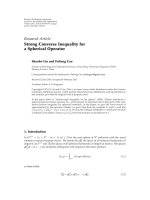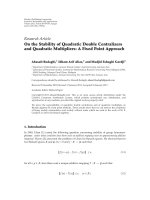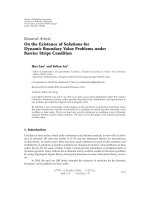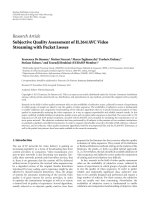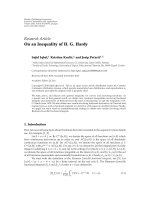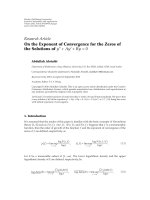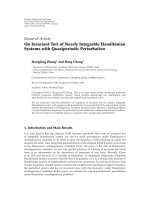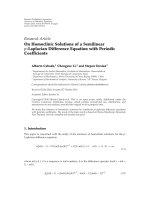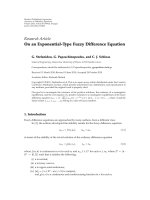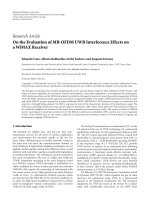Báo cáo hóa học: " Research Article On an Inequality of H. G. Hardy" pptx
Bạn đang xem bản rút gọn của tài liệu. Xem và tải ngay bản đầy đủ của tài liệu tại đây (587.28 KB, 23 trang )
Hindawi Publishing Corporation
Journal of Inequalities and Applications
Volume 2010, Article ID 264347, 23 pages
doi:10.1155/2010/264347
Research Article
OnanInequalityofH.G.Hardy
Sajid Iqbal,
1
Kristina Kruli´c,
2
and Josip P eˇcari´c
1, 2
1
Abdus Salam School of Mathematical Sciences, GC University, Lahore 54600, Pakistan
2
Faculty of Textile Technology , University of Zagreb, Prilaz baruna Filipovi
´
ca 28a, 10000 Zagreb, Croatia
Correspondence should be addressed to Sajid Iqbal, sajid
Received 18 June 2010; Accepted 16 October 2010
Academic Editor: Q. Lan
Copyright q 2010 Sajid Iqbal et al. This is an open access article distributed under the Creative
Commons Attribution License, which permits unrestricted use, distribution, and reproduction in
any medium, provided the original work is properly cited.
We state, prove, and discuss new general inequality for convex and increasing functions. As
a special case of that general result, we obtain new fractional inequalities involving fractional
integrals and derivatives of Riemann-Liouville type. Consequently, we get the inequality of H.
G. Har dy from 1918. We also obtain new results involving fractional derivatives of Canavati and
Caputo types as well as fractional integrals of a function with respect to another function. Finally,
we apply our main result to multidimensional settings to obtain new results involving mixed
Riemann-Liouville fractional integrals.
1. Introduction
First, let us recall some facts about fractional derivatives needed in the sequel, for more details
see, for example, 1, 2.
Let 0 <a<b≤∞.ByC
m
a, b,wedenotethespaceofallfunctionsona, b which
have continuous derivatives up to order m,andACa, b is the space of all absolutely
continuous functions on a, b.ByAC
m
a, b,wedenotethespaceofallfunctionsg ∈
C
m
a, b with g
m−1
∈ ACa, b.Foranyα ∈ ,wedenotebyα the integral part of α the
integer k satisfying k ≤ α<k 1,andα is the ceiling of α min{n ∈
,n ≥ α}.ByL
1
a, b,
we denote the space of all functions integrable on the interval a, b,andbyL
∞
a, b the set
of all functions measurable and essentially bounded on a, b. Clearly, L
∞
a, b ⊂ L
1
a, b.
We start with the definition o f the Riemann-Liouville fractional integrals,see3.Let
a, b, −∞ <a<b<∞ be a finite interval on the real axis
. The Riemann-Liouville
fractional integrals I
α
a
f and I
α
b
−
f of order α>0aredefinedby
I
α
a
f
x
1
Γ
α
x
a
f
t
x − t
α−1
dt,
x>a
, 1.1
2 Journal of Inequalities and Applications
I
α
b
−
f
x
1
Γ
α
b
x
f
t
t − x
α−1
dt,
x<b
, 1.2
respectively. Here Γα is the Gamma function. These integrals are called the left-sided and
the right-sided fractional integrals. We denote some properties of the operators I
α
a
f and I
α
b
−
f
of order α>0, see also 4. The first result yields that the fractional integral operators I
α
a
f
and I
α
b
−
f are bounded in L
p
a, b,1≤ p ≤∞,thatis
I
α
a
f
p
≤ Kf
p
, I
α
b
−
f
p
≤ Kf
p
,
1.3
where
K
b − a
α
αΓ
α
.
1.4
Inequality 1.3, that is the result involving the left-sided fractional integral, was proved by
H. G. Hardy in one of his first papers, see 5. He did not write down the constant, but the
calculation of the constant was hidden inside his proof.
Throughout this paper, all measures are assumed to be positive, all functions are
assumed to be positive and measurable, and expressions of the form 0 ·∞, ∞/∞,and0/0are
taken to be equal to zero. Moreover, by a weight u ux, we mean a nonnegative measurable
function on the actual interval or more general set.
The paper is organized in the following way. After this Introduction, in Section 2 we
state, prove, and discuss new general inequality for convex and increasing functions. As a
special case of that general result, we obtain new fractional inequalities involving fractional
integrals and derivatives of Riemann-Liouville type. Consequently, we get the inequality
of H. G. Hardy since 1918. We also obtain new results involving fractional derivatives
of Canavati and Caputo types as well as fractional integrals of a function with respect
to another function. We conclude this paper w ith new results involving mixed Riemann-
Liouville fractional integrals.
2. The Main Results
Let Ω
1
, Σ
1
,μ
1
and Ω
2
, Σ
2
,μ
2
be measure spaces with positive σ-finite measures, and let
k : Ω
1
× Ω
2
→ be a nonnegative function, and
K
x
Ω
2
k
x, y
dμ
2
y
,x∈ Ω
1
.
2.1
Throughout this paper, we suppose that Kx > 0a.e.onΩ
1
, and by a weight function
shortly: a weight, we mean a nonnegative measurable function on the actual set. Let Uk
denote the class of functions g : Ω
1
→ with the representation
g
x
Ω
2
k
x, y
f
y
dμ
2
y
,
2.2
where f : Ω
2
→ is a measurable function.
Journal of Inequalities and Applications 3
Our first result is given in the following theorem.
Theorem 2.1. Let u be a weight function on Ω
1
, k a nonnegative measurable function on Ω
1
× Ω
2
,
and K be defined on Ω
1
by 2.1. Assume that the function x → uxkx, y/Kx is integrable
on Ω
1
for each fixed y ∈ Ω
2
.Definev on Ω
2
by
v
y
:
Ω
1
u
x
k
x, y
K
x
dμ
1
x
< ∞.
2.3
If φ : 0, ∞ →
is convex and increasing function, then the inequality
Ω
1
u
x
φ
g
x
K
x
dμ
1
x
≤
Ω
2
v
y
φ
f
y
dμ
2
y
2.4
holds for all measurable functions f : Ω
2
→ and for all functions g ∈ Uk.
Proof. By using Jensen’s inequality and the Fubini theorem, since φ is increasing function, we
find that
Ω
1
u
x
φ
g
x
K
x
dμ
1
x
Ω
1
u
x
φ
1
K
x
Ω
2
k
x, y
f
y
dμ
2
y
dμ
1
x
≤
Ω
1
u
x
K
x
Ω
2
k
x, y
φ
f
y
dμ
2
y
dμ
1
x
Ω
2
φ
f
y
Ω
1
u
x
k
x, y
K
x
dμ
1
x
dμ
2
y
Ω
2
v
y
φ
f
y
dμ
2
y
,
2.5
and the proof is complete.
As a special case of Theorem 2.1, we get the following result.
Corollary 2.2. Let u be a weight function on a, b and α>0. I
α
a
f denotes the Riemann-Liouville
fractional integral of f.Definev on a, b by
v
y
: α
b
y
u
x
x − y
α−1
x − a
α
dx < ∞.
2.6
If φ : 0, ∞ →
is convex and increasing function, then the inequality
b
a
u
x
φ
Γ
α 1
x − a
α
I
α
a
f
x
dx ≤
b
a
v
y
φ
f
y
dy
2.7
holds.
4 Journal of Inequalities and Applications
Proof. Applying Theorem 2.1 with Ω
1
Ω
2
a, b, dμ
1
xdx, dμ
2
ydy,
k
x, y
⎧
⎪
⎨
⎪
⎩
x − y
α−1
Γ
α
,a≤ y ≤ x,
0,x<y≤ b,
2.8
we get that Kxx − a
α
/Γα 1 and gxI
α
a
fx,so2.7 follows.
Remark 2.3. In particular for the weight function uxx − a
α
,x∈ a, b in Corollary 2.2,
we obtain the inequality
b
a
x − a
α
φ
Γ
α 1
x − a
α
I
α
a
f
x
dx ≤
b
a
b − y
α
φ
f
y
dy.
2.9
Although 2.4 holds for all convex and increasing functions, some choices of φ are of
particular interest. Namely, we will consider power function. Let q>1andthefunction
φ :
→ be defined by φxx
q
,then2.9 reduces to
b
a
x − a
α
Γα 1
x − a
α
I
α
a
fx
q
dx ≤
b
a
b − y
α
fy
q
dy.
2.10
Since x ∈ a, b and α1 − q < 0, then we obtain that the left hand side of 2.10 is
b
a
x − a
α
Γα 1
x − a
α
|I
α
a
fx|
q
dx ≥
b − a
α1−q
Γ
α 1
q
b
a
I
α
a
f
x
q
dx 2.11
and the right-hand side of 2.10 is
b
a
b − y
α
fy
q
dy ≤
b − a
α
b
a
fy
q
dy.
2.12
Combining 2.11 and 2.12,weget
b
a
I
α
a
fx
q
dx ≤
b − a
α
Γα 1
q
b
a
fy
q
dy.
2.13
Taking power 1/q on both sides, we obtain 1.3.
Corollary 2.4. Let u be a weight function on a, b and α>0. I
α
b
−
f denotes the Riemann-Liouville
fractional integral of f.Definev on a, b by
v
y
: α
y
a
u
x
y − x
α−1
b − x
α
dx < ∞.
2.14
Journal of Inequalities and Applications 5
If φ : 0, ∞ →
is convex and increasing function, then the inequality
b
a
u
x
φ
Γ
α 1
b − x
α
I
α
b
−
f
x
dx ≤
b
a
v
y
φ
f
y
dy
2.15
holds.
Proof. Similar to the proof of Corollary 2.2.
Remark 2.5. In particular for the weight function uxb − x
α
,x∈ a, b in Corollary 2.4,
we obtain the inequality
b
a
b − x
α
φ
Γ
α 1
b − x
α
I
α
b
−
f
x
dx ≤
b
a
y − a
α
φ
f
y
dy.
2.16
Let q>1andthefunctionφ :
→ be defined by φxx
q
,then2.16 reduces to
b
a
b − x
α
Γα 1
b − x
α
I
α
b
−
fx
q
dx ≤
b
a
y − a
α
fy
q
dy.
2.17
Since x ∈ a, b and α1 − q < 0, then we obtain that the left hand side of 2.17 is
b
a
b − x
α
Γα 1
b − x
α
I
α
b
−
fx
q
dx ≥
b − a
α1−q
Γ
α 1
q
b
a
I
α
b
−
fx
q
dx
2.18
and the right-hand side of 2.17 is
b
a
y − a
α
fy
q
dy ≤
b − a
α
b
a
fy
q
dy
. 2.19
Combining 2.18 and 2.19,weget
b
a
I
α
b
−
fx
q
dx ≤
b − a
α
Γα 1
q
b
a
fy
q
dy.
2.20
Taking power 1/q on both sides, we obtain 1.3.
Theorem 2.6. Let p, q > 1, 1/p 1/q 1, α>1/q, I
α
a
f and I
α
b
−
f denote the Riemann-Liouville
fractional integral of f, then the following inequalities
b
a
I
α
a
f
x
q
dx ≤ C
b
a
f
y
q
dy,
2.21
b
a
I
α
b
−
fx
q
dx ≤ C
b
a
fy
q
dy
2.22
hold, where C b − a
qα
/Γα
q
qαpα − 11
q−1
.
6 Journal of Inequalities and Applications
Proof. We will prove only inequality 2.21, since the proof of 2.22 is analogous. We have
I
α
a
f
x
≤
1
Γ
α
x
a
f
t
x − t
α−1
dt.
2.23
Then by the H
¨
older inequality, the right-hand side of the above inequality is
≤
1
Γ
α
x
a
x − t
pα−1
dt
1/p
x
a
|ft|
q
dt
1/q
1
Γ
α
x − a
α−11/p
p
α − 1
1
1/p
x
a
|ft|
q
dt
1/q
≤
1
Γ
α
x − a
α−11/p
p
α − 1
1
1/p
b
a
|ft|
q
dt
1/q
.
2.24
Thus, we have
I
α
a
f
x
≤
1
Γ
α
x − a
α−11/p
p
α − 1
1
1/p
b
a
|ft|
q
dt
1/q
, for every x ∈
a, b
.
2.25
Consequently, we find
I
α
a
fx
q
≤
1
Γ
α
q
x − a
qα−1q/p
p
α − 1
1
q/p
b
a
ft
q
dt
, 2.26
and we obtain
b
a
I
α
a
fx
q
dx ≤
b − a
qα−1q/p1
Γ
α
q
q
α − 1
q/p 1
p
α − 1
1
q/p
b
a
ft
q
dt.
2.27
Remark 2.7. For α ≥ 1, inequalities 2.21 and 2.22 are refinements of 1.3 since
qα
p
α − 1
1
q−1
≥ qα
q
>α
q
, so C<
b − a
α
αΓα
q
.
2.28
We proved that Theorem 2.6 is a refinement of 1.3, and Corollaries 2.2 and 2.4 are
generalizations of 1.3.
Next, we give results with respect to the generalized Riemann-Liouville fractional
derivative. Let us recall the definition, for details see 1, page 448.
Journal of Inequalities and Applications 7
We define the generalized Riemann-Liouville fractional derivative of f of order α>0
by
D
α
a
f
x
1
Γ
n − α
d
dx
n
x
a
x − y
n−α−1
f
y
dy,
2.29
where n α1,x∈ a, b.
For a, b ∈
, we say that f ∈ L
1
a, b has an L
∞
fractional derivative D
α
a
f α>0 in
a, b, if and only if
1 D
α−k
a
f ∈ Ca, b, k 1, ,nα1,
2 D
α−1
a
f ∈ ACa, b,
3 D
α
a
∈ L
∞
a, b.
Next, lemma is very useful in the upcoming corollary see 1, page 449 and 2.
Lemma 2.8. Let β>α≥ 0 and let f ∈ L
1
a, b have an L
∞
fractional derivative D
β
a
f in a, b and
let
D
β−k
a
f
a
0,k 1, ,
β
1,
2.30
then
D
α
a
f
x
1
Γ
β − α
x
a
x − y
β−α−1
D
β
a
f
y
dy,
2.31
for all a ≤ x ≤ b.
Corollary 2.9. Let u be a weight function on a, b, and let assumptions in Lemma 2.8 be satisfied.
Define v on a, b by
v
y
:
β − α
b
y
u
x
x − y
β−α−1
x − a
β−α
dx < ∞.
2.32
If φ : 0, ∞ →
is convex and increasing function, then the inequality
b
a
u
x
φ
Γ
β − α 1
x − a
β−α
D
α
a
f
x
dx ≤
b
a
v
y
φ
D
β
a
f
y
dy 2.33
holds.
Proof. Applying Theorem 2.1 with Ω
1
Ω
2
a, b, dμ
1
xdx, dμ
2
ydy,
k
x, y
⎧
⎪
⎨
⎪
⎩
x − y
β−α−1
Γ
β − α
,a≤ y ≤ x,
0,x<y≤ b,
2.34
8 Journal of Inequalities and Applications
we get that Kxx − a
β−α
/Γβ − α 1.Replacef by D
β
a
f. Then, by Lemma 2.8, gx
D
α
a
fx and we get 2.33.
Remark 2.10. In particular for the weight function uxx −a
β−α
, x ∈ a, b in Corollary 2.9,
we obtain the inequality
b
a
x − a
β−α
φ
Γ
β − α 1
x − a
β−α
D
α
a
f
x
dx ≤
b
a
b − y
β−α
φ
D
β
a
f
y
dy. 2.35
Let q>1andthefunctionφ :
→ be defined by φxx
q
, then after some calculation,
we obtain
b
a
D
α
a
fx
q
dx ≤
b − a
β−α
Γβ − α 1
q
b
a
D
β
a
fy
q
dy.
2.36
Next, we define Canavati-type fractional derivative ν-fractional derivative of f, for details
see 1, page 446.Weconsider
C
ν
a, b
f ∈ C
n
a, b
: I
n−ν1
a
f
n
∈ C
1
a, b
, 2.37
ν>0,nν.Letf ∈ C
ν
a, b. We define the generalized ν-fractional derivative of f over
a, b as
D
ν
a
f
I
n−ν1
a
f
n
,
2.38
the derivative with respect to x.
Lemma 2.11. Let ν ≥ γ 1,whereγ ≥ 0 and f ∈ C
ν
a, b. Assume that f
i
a0, i
0, 1, ,ν − 1,then
D
γ
a
f
x
1
Γ
ν − γ
x
a
x − t
ν−γ−1
D
ν
a
f
t
dt,
2.39
for all x ∈ a, b.
Corollary 2.12. Let u be a weight function on a, b, and let assumptions in Lemma 2.11 be satisfied.
Define v on a, b by
v
y
:
ν − γ
b
y
u
x
x − y
ν−γ−1
x − x
0
ν−γ
dx < ∞.
2.40
Journal of Inequalities and Applications 9
If φ : 0, ∞ →
is convex and increasing function, then the inequality
b
a
u
x
φ
Γ
ν − γ 1
x − a
ν−γ
D
γ
a
f
x
dx ≤
b
a
v
y
φ
D
ν
a
f
y
dy 2.41
holds.
Proof. Similar to the proof of Corollary 2.9.
Remark 2.13. In particular for the weight function uxx−a
ν−γ
, x ∈ a, b in Corollary 2.12,
we obtain the inequality
b
a
x − a
ν−γ
φ
Γ
ν − γ 1
x − a
ν−γ
D
γ
a
f
x
dx ≤
b
a
b − y
ν−γ
φ
D
ν
a
f
y
dy. 2.42
Let q>1andthefunctionφ :
→ be defined by φxx
q
,then2.42 reduces to
Γ
ν − γ 1
q
b
a
x − a
ν−γ 1−q
D
γ
a
fx
q
dx ≤
b
a
b − y
ν−γ
D
ν
a
fy
q
dy.
2.43
Since x ∈ a, b and ν − γ1 − q ≤ 0, then we obtain
b
a
D
γ
a
fx
q
dx ≤
b − a
ν−γ
Γν − γ 1
q
b
a
D
ν
a
fy
q
dy.
2.44
Taking power 1/q on both sides of 2.44,weobtain
D
γ
a
f
x
q
≤
b − a
ν−γ
Γ
ν − γ 1
D
ν
a
f
y
q
.
2.45
When γ 0, we find that
Γ
ν 1
q
b
a
x − a
ν1−q
f
x
q
dx ≤
b
a
b − y
ν
D
ν
a
f
y
q
dy,
2.46
that is,
f
q
≤
b − a
ν
Γ
ν 1
D
ν
a
f
y
q
.
2.47
In the next corollary, we give results with respect to the Caputo fractional derivative.Let
us recall the definition, for details see 1, page 449.
10 Journal of Inequalities and Applications
Let α ≥ 0, n α, g ∈ AC
n
a, b. The Caputo fractional derivative is given by
D
α
∗a
g
t
1
Γ
n − α
x
a
g
n
y
x − y
α−n1
dy,
2.48
for all x ∈ a, b. The above function exists almost everywhere for x ∈ a, b.
Corollary 2.14. Let u be a weight function on a, b and α>0. D
α
∗a
g denotes the Caputo fractional
derivative of g.Definev on a, b by
v
y
:
n − α
b
y
u
x
x − y
n−α−1
x − a
n−α
dx < ∞.
2.49
If φ : 0, ∞ →
is convex and increasing function, then the inequality
b
a
u
x
φ
Γ
n − α 1
x − a
n−α
D
α
∗a
g
x
dx ≤
b
a
v
y
φ
g
n
y
dy
2.50
holds.
Proof. Applying Theorem 2.1 with Ω
1
Ω
2
a, b, dμ
1
xdx, dμ
2
ydy,
k
x, y
⎧
⎪
⎨
⎪
⎩
x − y
n−α−1
Γ
n − α
,a≤ y ≤ x,
0,x<y≤ b,
2.51
we get that Kxx − a
n−α
/Γn − α 1.Replacef by g
n
,sog becomes D
α
∗a
g and 2.50
follows.
Remark 2.15. In particular for the weight function uxx − a
n−α
, x ∈ a, b in
Corollary 2.14, we obtain the inequality
b
a
x − a
n−α
φ
Γ
n − α 1
x − a
n−α
D
α
∗a
g
x
dx ≤
b
a
b − y
n−α
φ
g
n
y
dy.
2.52
Let q>1andthefunctionφ :
→ be defined by φxx
q
, then after some calculation,
we obtain
b
a
D
α
∗a
gx
q
dx ≤
b − a
n−α
Γn − α 1
q
b
a
g
n
y
q
dy.
2.53
Taking power 1/q on both sides, we obtain
D
α
∗a
g
x
q
≤
b − a
n−α
Γ
n − α 1
g
n
y
q
.
2.54
Journal of Inequalities and Applications 11
Theorem 2.16. Let p, q > 1, 1/p 1/q 1, n − α>1/q, D
α
∗a
fx denotes the Caputo fractional
derivative of f, then the following inequality
b
a
D
α
∗a
fx
q
dx ≤
b − a
qn−α
Γ
n − α
q
p
n − α − 1
1
q/p
q
n − α
b
a
f
n
y
q
dy 2.55
holds.
Proof. Similar to the proof of Theorem 2.6.
The following result is given 1, page 450.
Lemma 2.17. Let α ≥ γ 1, γ>0,andn α. Assume that f ∈ AC
n
a, b such that f
k
a0,
k 0, 1, ,n− 1,andD
α
∗a
f ∈ L
∞
a, b,thenD
γ
∗a
f ∈ Ca, b, and
D
γ
∗a
f
x
1
Γ
α − γ
x
a
x − y
α−γ−1
D
α
∗a
f
y
dy,
2.56
for all a ≤ x ≤ b.
Corollary 2.18. Let u be a weight function on a, b and α>0. D
α
∗a
f denotes the Caputo fractional
derivative of f, and assumptions in Lemma 2.17 are satisfied. Define v on a, b by
v
y
:
α − γ
b
y
u
x
x − y
α−γ−1
x − a
α−γ
dx < ∞.
2.57
If φ : 0, ∞ →
is convex and increasing function, then the inequality
b
a
u
x
φ
Γ
α − γ 1
x − a
α−γ
D
γ
∗a
f
x
dx ≤
b
a
v
y
φ
D
α
∗a
f
y
dy 2.58
holds.
Proof. Applying Theorem 2.1 with Ω
1
Ω
2
a, b, dμ
1
xdx, dμ
2
ydy,
k
x, y
⎧
⎪
⎨
⎪
⎩
x − y
α−γ−1
Γ
α − γ
,a≤ y ≤ x,
0,x<y≤ b,
2.59
we get that Kxx − a
α−γ
/Γα − γ 1.Replacef by D
α
∗a
f,sog becomes D
γ
∗a
f and 2.58
follows.
12 Journal of Inequalities and Applications
Remark 2.19. In particular for the weight function uxx−a
α−γ
, x ∈ a, b in Corollary 2.18,
we obtain the inequality
b
a
x − a
α−γ
φ
Γ
α − γ 1
x − a
α−γ
D
γ
∗a
f
x
dx ≤
b
a
b − y
α−γ
φ
D
α
∗a
f
y
dy. 2.60
Let q>1andthefunctionφ :
→ be defined by φxx
q
, then after some calculation,
we obtain
b
a
D
γ
∗a
fx
q
dx ≤
b − a
α−γ
Γα − γ 1
q
b
a
D
α
∗a
fy
q
dy.
2.61
For γ 0, we obtain
b
a
fx
q
dx ≤
b − a
α
Γα 1
q
b
a
D
α
∗a
fy
q
dy.
2.62
We continue with definitions and some properties of the fractional integrals of a function
f with respect to given function g. For details see, for example, 3,page99.
Let a, b, −∞ ≤ a<b≤∞be a finite or infinite interval of the real line
and α>0.
Also let g be an increasing function on a, b and g
a continuous function on a, b.Theleft-
and right-sided fractional integrals of a function f with respect to another function g in a, b
are given by
I
α
a;g
f
x
1
Γ
α
x
a
g
t
f
t
dt
g
x
− g
t
1−α
,x>a,
2.63
I
α
b−;g
f
x
1
Γ
α
b
x
g
t
f
t
dt
g
t
− g
x
1−α
,x<b,
2.64
respectively.
Corollary 2.20. Let u be a weight function on a, b,andletg be an increasing function on a, b,
such that g
is a continuous function on a, b and α>0. I
α
a
;g
f denotes the left-sided fractional
integral of a function f with respect to another function g in a, b.Definev on a, b by
v
y
: αg
y
b
y
u
x
g
x
− g
y
α−1
g
x
− g
a
α
dx < ∞.
2.65
If φ : 0, ∞ →
is convex and increasing function, then the inequality
b
a
u
x
φ
Γ
α 1
g
x
− g
a
α
I
α
a
;g
f
x
dx ≤
b
a
v
y
φ
f
y
dy 2.66
holds.
Journal of Inequalities and Applications 13
Proof. Applying Theorem 2.1 with Ω
1
Ω
2
a, b, dμ
1
xdx, dμ
2
ydy,
k
x, y
⎧
⎪
⎨
⎪
⎩
1
Γ
α 1
g
y
g
x
− g
y
1−α
,a≤ y ≤ x,
0,x<y≤ b,
2.67
we get that Kx1/Γα 1gx − ga
α
,so2.66 follows.
Remark 2.21. In particular for the weight function uxg
xgx − ga
α
, x ∈ a, b in
Corollary 2.20, we obtain the inequality
b
a
g
x
g
x
− g
a
α
φ
Γ
α 1
g
x
− g
a
α
I
α
a
;g
f
x
dx
≤
b
a
g
y
g
b
− g
y
α
φ
f
y
dy.
2.68
Let q>1andthefunctionφ :
→ be defined by φxx
q
,then2.68 reduces to
Γ
α 1
q
b
a
g
x
g
x
− g
a
α1−q
I
α
a
;g
fx
q
dx
≤
b
a
g
y
g
b
− g
y
α
fy
q
dy.
2.69
Since x ∈ a, b and α1 − q < 0, g is increasing, then gx − ga
α1−q
> gb − ga
α1−q
and gb − gy
α
< gb − ga
α
and we obtain
b
a
g
x
I
α
a
;g
fx
q
dx ≤
g
b
− g
a
α
Γα 1
q
b
a
g
y
fy
q
dy.
2.70
Remark 2.22. If gxx,thenI
α
a
;x
fx reduces to I
α
a
fx Riemann-Liouville fractional
integral and 2.70 becomes 2.13.
Analogous to Corollary 2.20, we obtain the following result.
Corollary 2.23. Let u be a weight function on a, b,andletg be an increasing function on a, b,
such that g
is a continuous function on a, b and α>0. I
α
b
−
;g
f denotes the right-sided fractional
integral of a function f with respect to another function g in a, b.Definev on a, b by
v
y
: αg
y
y
a
u
x
g
y
− g
x
α−1
g
b
− g
x
α
dx < ∞.
2.71
14 Journal of Inequalities and Applications
If φ : 0, ∞ →
is convex and increasing function, then the inequality
b
a
u
x
φ
Γ
α 1
g
b
− g
x
α
I
α
b
−
;g
f
x
dx ≤
b
a
v
y
φ
f
y
dy 2.72
holds.
Remark 2.24. In particular for the weight function uxg
xgb − gx
α
, x ∈ a, b and
for function φxx
q
, q>1, we obtain after some calculation
b
a
g
x
I
α
b
−
;g
fx
q
dx ≤
g
b
− g
a
α
Γ
α 1
q
b
a
g
y
fy
q
dy.
2.73
Remark 2.25. If gxx,thenI
α
b
−
;x
fx reduces to I
α
b
−
fx Riemann-Liouville fractional
integral and 2.73 becomes 2.20.
The refinements of 2.70 and 2.73 for α>1/q are given in the following theorem.
Theorem 2.26. Let p, q > 1, 1/p 1/q 1, α>1/q, I
α
a
;g
f and I
α
b
−
;g
f denote the left-sided and
right-sided fractional integral of a function f with respect to another function g in a, b, then the
following inequalities:
b
a
I
α
a
;g
f
x
q
g
x
dx ≤
g
b
− g
a
αq
αq
Γ
α
q
p
α − 1
1
q/p
b
a
f
y
q
g
y
dy,
b
a
I
α
b
−
;g
f
x
q
g
x
dx ≤
g
b
− g
a
αq
αq
Γ
α
q
p
α − 1
1
q/p
b
a
f
y
q
g
y
dy
2.74
hold.
We continue by defining Hadamard type fractional integrals.
Let a, b, 0 ≤ a<b≤∞be a finite or infinite interval of the half-axis
and α>0.
The left- and right-sided Hadamard fractional integrals of order α are given by
J
α
a
f
x
1
Γ
α
x
a
log
x
y
α−1
f
y
dy
y
,x>a,
2.75
J
α
b−
f
x
1
Γ
α
b
x
log
y
x
α−1
f
y
dy
y
,x<b,
2.76
respectively.
Journal of Inequalities and Applications 15
Notice that Hadamard fractional integrals of order α are special case of the left- and
right-sided fractional integrals of a function f with respect to another function gxlogx
in a, b,where0≤ a<b≤∞,so2.70 reduces to
b
a
J
α
a
fx
q
dx
x
≤
log
b/a
α
Γα 1
q
b
a
f
y
q
dy
y
,
2.77
and 2.73 becomes
b
a
J
α
b−
f
x
q
dx
x
≤
log
b/a
α
Γα 1
q
b
a
f
y
q
dy
y
.
2.78
Also, from Theorem 2.26 we obtain refinements of 2.77 and 2.78,forα>1/q,
b
a
J
α
a
fx
q
dx
x
≤
log
b/a
qα
qα
Γ
α
q
p
α − 1
1
q/p
b
a
f
y
q
dy
y
,
b
a
J
α
b−
fx
q
dx
x
≤
log
b/a
qα
qα
Γ
α
q
p
α − 1
1
q/p
b
a
f
y
q
dy
y
.
2.79
Some results involving Hadamard type fractional integrals are given in 3, page 110.
Here, we mention the following result that can not be compared with our result.
Let α>0, 1 ≤ p ≤∞,and0≤ a<b≤∞, then the operators J
α
a
f and J
α
b−
f are bounded
in L
p
a, b as follows:
J
α
a
f
p
≤ K
1
f
p
, J
α
b−
f
p
≤ K
2
f
p
, 2.80
where
K
1
1
Γ
α
logb/a
0
t
α−1
e
t/p
dt, K
2
1
Γ
α
logb/a
0
t
α−1
e
−t/p
dt.
2.81
Now we present the definitions and some properties of the Erd
´
elyi-Kober type fractional
integrals. Some of these definitions and results were presented by Samko et al. in 4.
Let a, b, 0 ≤ a<b≤∞ be a finite or infinite interval of the half-axis
.Alsolet
α>0, σ>0, and η ∈
. We consider the left- and right-sided integrals of order α ∈ defined
by
I
α
a
;σ;η
f
x
σx
−σαη
Γ
α
x
a
t
σησ−1
f
t
dt
x
σ
− t
σ
1−α
,
2.82
I
α
b
−
;σ;η
f
x
σx
ση
Γ
α
b
x
t
σ1−η−α−1
f
t
dt
t
σ
− x
σ
1−α
,
2.83
respectively. Integrals 2.82 and 2.83 are called the Erd
´
elyi-Kober type fractional integrals.
16 Journal of Inequalities and Applications
Corollary 2.27. Let u be a weight function on a, b,
2
F
1
a, b; c; z denotes the hypergeometric
function, and I
α
a
;σ;η
f denotes the Erd
´
elyi-Kober type fractional left-sided integral. Define v by
v
y
: ασy
σησ−1
b
y
u
x
x
−ση
x
σ
− y
σ
α−1
x
σ
− a
σ
α
2
F
1
α, −η; α 1; 1 −
a/x
σ
dx < ∞.
2.84
If φ : 0, ∞ →
is convex and increasing function, then the inequality
b
a
u
x
φ
Γ
α 1
1 −
a/x
σ
α
2
F
1
α, −η; α 1; 1 −
a/x
σ
I
α
a
;σ;η
f
x
dx
≤
b
a
v
y
φ
f
y
dy
2.85
holds.
Proof. Applying Theorem 2.1 with Ω
1
Ω
2
a, b, dμ
1
xdx, dμ
2
ydy,
k
x, y
⎧
⎪
⎨
⎪
⎩
1
Γ
α
σx
−σαη
x
σ
− y
σ
1−α
y
σησ−1
,a≤ y ≤ x,
0,x<y≤ b,
2.86
we get that Kx1/Γα11 − a/x
σ
α
2
F
1
α, −η; α1; 1−a/x
σ
,so2.85 follows.
Remark 2.28. In particular for the weight function uxx
σ−1
x
σ
− a
σ
α
2
F
1
x where
2
F
1
x
2
F
1
α, −η; α 1; 1 − a/x
σ
in Corollary 2.27, we obtain the inequality
b
a
x
σ−1
x
σ
− a
σ
α
2
F
1
x
φ
Γ
α 1
1 −
a/x
σ
α
2
F
1
x
I
α
a
;σ;η
f
x
dx
≤
b
a
y
σ−1
b
σ
− y
σ
α
2
F
1
y
φ
f
y
dy,
2.87
where
2
F
1
y
2
F
1
α, η; α 1; 1 − a/y
σ
.
Corollary 2.29. Let u be a weight function on a, b,
2
F
1
a, b; c; z denotes the hypergeometric
function, and I
α
b
−
;σ;η
f denotes the Erd
´
elyi-Kober type fractional right-sided integral. Define v by
v
y
: ασy
σ1−α−η−1
y
a
u
x
x
σηα
y
σ
− x
σ
α−1
b
σ
− x
σ
α
2
F
1
α, α η; α 1; 1 −
b/x
σ
dx < ∞.
2.88
Journal of Inequalities and Applications 17
If φ : 0, ∞ →
is convex and increasing function, then the inequality
b
a
u
x
φ
Γ
α 1
b/x
σ
− 1
α
2
F
1
α, α η; α 1; 1 −
b/x
σ
I
α
b
−
;σ;η
f
x
dx
≤
b
a
v
y
φ
f
y
dy
2.89
holds.
Proof. Applying Theorem 2.1 with Ω
1
Ω
2
a, b, dμ
1
xdx, dμ
2
ydy,
k
x, y
⎧
⎪
⎨
⎪
⎩
1
Γ
α
σx
ση
y
σ
− x
σ
1−α
y
σ1−α−η−1
,x<y≤ b,
0,a≤ y ≤ x,
2.90
we get that Kx1/Γα1b/x
σ
− 1
α
2
F
1
α, αη; α1; 1−b/x
σ
,so2.89 follows.
Remark 2.30. In particular for the weight function uxx
σ−1
b
σ
− x
σ
α
2
F
1
x where
2
F
1
x
2
F
1
α, α η; α 1; 1 − b/x
σ
in Corollary 2.29, we obtain the inequality
b
a
x
σ−1
b
σ
− x
σ
α
2
F
1
x
φ
Γ
α 1
b/x
σ
− 1
α
2
F
1
x
I
α
b
−
;σ;η
f
x
dx
≤
b
a
y
σ−1
y
σ
− a
σ
α
2
F
1
y
φ
f
y
dy,
2.91
where
2
F
1
y
2
F
1
α, −α − η; α 1; 1 − b/y
σ
.
In the next corollary, we give some results related to the Caputo radial fractional
derivative. Let us recall the following definition, see 1, page 463.
Let f :
A → , ν ≥ 0, n : ν,suchthatf·ω ∈ AC
n
R
1
,R
2
,forallω ∈ S
N−1
,
where
A R
1
,R
2
× S
N−1
for N ∈ and S
N−1
: {x ∈
N
: |x| 1}.WecalltheCaputo
radial fractional derivative as the following function:
∂
ν
∗R
1
f
x
∂r
ν
:
1
Γ
n − ν
r
R
1
r − t
n−ν−1
∂
n
f
tω
∂r
n
dt,
2.92
where x ∈
A,thatis,x rω, r ∈ R
1
,R
2
, ω ∈ S
N−1
.
Clearly,
∂
0
∗R
1
f
x
∂r
0
f
x
,
∂
ν
∗R
1
f
x
∂r
ν
∂
ν
f
x
∂r
ν
if ν ∈ , the usual radial derivative.
2.93
18 Journal of Inequalities and Applications
Corollary 2.31. Let u be a weight function on R
1
,R
2
,and∂
ν
∗R
1
fx/∂r
ν
denotes the Caputo radial
fractional derivative of f.Definev on R
1
,R
2
by
v
t
:
n − ν
R
2
t
u
r
r − t
n−ν−1
r − R
1
n−ν
dr < ∞.
2.94
If φ : 0, ∞ → is convex and increasing, then the inequality
R
2
R
1
u
r
φ
Γ
n − ν 1
r − R
1
n−ν
∂
ν
∗R
1
f
x
∂r
ν
dr ≤
R
2
R
1
v
t
φ
∂
n
f
tω
∂r
n
dt 2.95
holds.
Proof. Apply Theorem 2.1 with Ω
1
Ω
2
R
1
,R
2
, dμ
1
xdr, dμ
2
ydt,and
k
r, t
⎧
⎪
⎨
⎪
⎩
r − t
n−ν−1
Γ
n − ν
,R
1
≤ t ≤ r,
0,r<t≤ R
2
.
2.96
Then replace fx by ∂
n
ftω/∂r
n
,so2.95 follows.
Remark 2.32. In particular for the weight function urr − R
1
n−ν
, r ∈ R
1
,R
2
,weobtain
the following inequality:
R
2
R
1
r − R
1
n−ν
φ
Γ
n − ν 1
r − R
1
n−ν
∂
ν
∗R
1
f
x
∂r
ν
dr ≤
R
2
R
1
R
2
− t
n−ν
φ
∂
n
f
tω
∂r
n
dt. 2.97
Let q>1andφ :
→ be defined by φxx
q
,then2.97 becomes
Γn − ν 1
q
R
2
R
1
r − R
1
n−ν1−q
∂
ν
∗R
1
fx
∂r
ν
q
dr ≤
R
2
R
1
R
2
− t
n−ν
∂
n
ftω
∂r
n
q
dt.
2.98
Since r ∈ R
1
,R
2
and 1 − qn − ν ≤ 0, we obtain
R
2
R
1
∂
ν
∗R
1
fx
∂r
ν
q
dr ≤
R
2
− R
1
n−ν
Γn − ν 1
q
R
2
R
1
∂
n
ftω
∂r
n
q
dt.
2.99
Taking power 1/q on both sides, we get
∂
ν
∗R
1
fx
∂r
ν
q
≤
R
2
− R
1
n−ν
Γ
n − ν 1
∂
n
ftω
∂r
n
q
.
2.100
Journal of Inequalities and Applications 19
If ν 0, then
f
x
q
≤
R
2
− R
1
n
Γ
n 1
∂
n
f
tω
∂r
n
q
.
2.101
If ν ∈
,then
∂
ν
fx
∂r
ν
q
≤
R
2
− R
1
n−ν
Γ
n − ν 1
∂
n
ftω
∂r
n
q
.
2.102
Now, we continue with the Riemann-Liouville radial fractional derivative of fof order β,
but first we need to define the following: let B
X
stand for the Borel class on space X and
define the measure R
N
on 0, ∞, B
0,∞
by
R
N
Γ
Γ
r
N−1
dr, any Γ ∈B
0,∞
.
2.103
Now, let f ∈ L
1
AL
1
R
1
,R
2
× S
N−1
.
For a fixed ω ∈ S
N−1
,wedefine
g
ω
r
: f
rω
f
x
, 2.104
where
x ∈ A : B
0,R
2
−
B0,R
1
,
0 <R
1
≤ r ≤ R
2
,r
|
x
|
,ω
x
r
∈ S
N−1
.
2.105
The above led to the following definition of Riemann-Liouville radial fractional derivative.
For details see 1, page 466.Letβ>0, m :β1, f ∈ L
1
A,andA is the spherical shell.
We define
∂
β
R
1
f
x
∂r
β
D
β
R
1
f
rω
⎧
⎪
⎨
⎪
⎩
1
Γ
m − β
∂
∂r
m
r
R
1
r − t
m−β−1
f
tω
dt, ω ∈ S
N−1
− K
f
,
0,ω∈ K
f
,
2.106
where
x rω ∈ A, r ∈
R
1
,R
2
,ω∈ S
N−1
,
K
f
:
ω ∈ S
N−1
: f
·ω
/
∈ L
1
R
1
,R
2
, B
R
1
,R
2
,R
N
.
2.107
20 Journal of Inequalities and Applications
If β 0, define
∂
β
R
1
f
x
∂r
β
: f
x
.
2.108
We call ∂
β
R
1
fx/∂r
β
the Riemann-Liouville radial fractional derivative of f of order β.
The following result is given in 1, page 466.
Lemma 2.33. Let ν ≥ γ 1, γ ≥ 0, n : ν, f :
A → with f ∈ L
1
A. Assume that f·ω ∈
AC
n
R
1
,R
2
, for every ω ∈ S
N−1
,andthat∂
ν
R
1
f·ω/∂r
ν
is measurable on R
1
,R
2
for every
ω ∈ S
N−1
. Also assume that there exists ∂
ν
R
1
frω/∂r
ν
∈ for every r ∈ R
1
,R
2
and for every
ω ∈ S
N−1
,and∂
ν
R
1
fω/∂r
ν
is measurable on A. Suppose that there exists M
1
> 0,
∂
ν
R
1
f
ω
∂r
ν
≤ M
1
, for e very
r, ω
∈
R
1
,R
2
× S
N−1
. 2.109
W e suppose that ∂
j
fR
1
ω/∂r
j
0, j 0, 1, ,n− 1, for every ω ∈ S
N−1
,then
∂
γ
R
1
f
x
∂r
γ
D
γ
R
1
f
rω
1
Γ
ν − γ
r
R
1
r − t
ν−γ−1
D
ν
R
1
f
tω
dt
2.110
is valid for every x ∈
A, that is, true for every r ∈ R
1
,R
2
and for every ω ∈ S
N−1
, γ>0.
Corollary 2.34. Let u be a weight function on R
1
,R
2
. Let the assumption of the Lemma 2.33 be
satisfied, and D
γ
R
1
frω denotes the Riemann-Liouville radial fractional derivative of f.Definev on
R
1
,R
2
by
v
t
:
ν − γ
R
2
t
u
r
r − t
ν−γ−1
r − R
1
ν−γ
dr < ∞.
2.111
If φ : 0, ∞ →
is convex and increasing, then the inequality
R
2
R
1
u
r
φ
Γ
ν − γ 1
r − R
1
ν−γ
D
γ
R
1
f
rω
dr ≤
R
2
R
1
v
t
φ
D
ν
R
1
f
tω
dt 2.112
holds.
Proof. Applying Theorem 2.1 with Ω
1
Ω
2
R
1
,R
2
,
k
r, t
⎧
⎪
⎨
⎪
⎩
r − t
ν−γ−1
Γ
ν − γ
,R
1
≤ t ≤ r,
0,r<t≤ R
2
,
2.113
Journal of Inequalities and Applications 21
we get that Krr − R
1
ν−γ
/Γν −γ 1.Replacef· by D
ν
R
1
f·ω, and then from the above
Lemma 2.33,wegetgrD
γ
R
1
frω. This will give us 2.112.
Remark 2.35. In particular for the weight function urr − R
1
ν−γ
, r ∈ R
1
,R
2
in above
Corollary 2.34 and for φxx
q
, q>1 we obtain, after some calculation, the following
inequality:
D
γ
R
1
frω
q
≤
R
2
− R
1
ν−γ
Γ
ν − γ 1
D
ν
R
1
ftω
q
.
2.114
If γ 0, then
f
rω
q
≤
R
2
− R
1
ν
Γ
ν 1
D
ν
R
1
ftω
q
.
2.115
In the previous corollaries, we derived only inequalities over some subsets of
.
However, Theorem 2.1 covers much more general situations. We conclude this paper with
multidimensional fractional integrals. Such operations of fractional integration in the n-
dimensional Euclidean space
n
, n ∈ are natural generalizations of the corresponding
one-dimensional fractional integrals and fractional derivatives, being taken with respect to
one or several variables.
For x x
1
, ,x
n
∈
n
and α α
1
, ,α
n
, we use the following notations:
Γ
α
Γ
α
1
···Γ
α
n
,
a, b
a
1
,b
1
×···×
a
n
,b
n
, 2.116
and by x > a,wemeanx
1
>a
1
, ,x
n
>a
n
.
The partial Riemann-Liouville fractional integrals of order α
k
> 0 with respect to the kth
variable x
k
are defined by
I
α
k
a
k
f
x
1
Γ
α
k
x
k
a
k
f
x
1
, ,x
k−1
,t
k
,x
k1
, ,x
n
x
k
− t
k
α
k
−1
dt
k
,
x
k
>a
k
,
2.117
I
α
k
b
k
−
f
x
1
Γ
α
k
b
k
x
k
f
x
1
, ,x
k−1
,t
k
,x
k1
, ,x
n
t
k
− x
k
α
k
−1
dt
k
,
x
k
<b
k
, 2.118
respectively. These definitions are valid for functions fxfx
1
, ,x
n
defined for x
k
>a
k
and x
k
<b
k
, respectively.
Next, we define the mixed Riemann-Liouville fractional integrals of order α>0as
I
α
a
f
x
1
Γ
α
x
1
a
1
···
x
n
a
n
f
t
x − t
α−1
dt,
x > a
,
I
α
b
−
f
x
1
Γ
α
b
1
x
1
···
b
n
x
n
f
t
t − x
α−1
dt,
x < b
.
2.119
22 Journal of Inequalities and Applications
Corollary 2.36. Let u be a weight function on a, b and α>0. I
α
a
f denotes the mixed partial
Riemann-Liouville fractional integral of f.Definev on a, b by
v
y
: α
b
1
y
1
···
b
n
y
n
u
x
x − y
α−1
x − a
α
dx < ∞.
2.120
If φ : 0, ∞ →
is convex and increasing function, then the inequality
b
1
a
1
···
b
n
a
n
u
x
φ
Γ
α 1
x − a
α
I
α
a
f
x
dx ≤
b
1
a
1
···
b
n
a
n
v
y
φ
f
y
dy
2.121
holds for all measurable functions f : a, b →
.
Proof. Applying Theorem 2.1 with Ω
1
Ω
2
a, b,
k
x, y
⎧
⎪
⎨
⎪
⎩
x − y
α−1
Γ
α
, a ≤ y ≤ x,
0, x < y ≤ b,
2.122
we get that Kxx − a
α
/Γα 1 and gxI
α
a
fx,so2.121 follows.
Corollary 2.37. Let u be a weight function on a, b and α>0. I
α
b
−
f denotes the mixed partial
Riemann-Liouville fractional integral of f.Definev on a, b by
v
y
: α
y
1
a
1
···
y
n
a
n
u
x
y − x
α−1
b − x
α
dx < ∞.
2.123
If φ : 0, ∞ →
is convex and increasing function, then the inequality
b
1
a
1
···
b
n
a
n
u
x
φ
Γ
α 1
b − x
α
I
α
b
−
f
x
dx ≤
b
1
a
1
···
b
n
a
n
v
y
φ
f
y
dy
2.124
holds for all measurable functions f : a, b →
.
Remark 2.38. Analogous to Remarks 2.3 and 2.5, we obtain multidimensional version of
inequality 1.3 for q>1 as follows:
b
1
a
1
···
b
n
a
n
I
α
a
fx
g
dx ≤
b − a
α
Γα 1
q
b
1
a
1
···
b
n
a
n
fy
q
dy,
b
1
a
1
···
b
n
a
n
I
α
b
−
fx
g
dx ≤
b − a
α
Γα 1
q
b
1
a
1
···
b
n
a
n
fy
q
dy.
2.125
Journal of Inequalities and Applications 23
Acknowledgments
The authors would like to express their gratitude to professor S. G. Samko for his help and
suggestions and also to the careful referee whose valuable advice improved the final version
of this paper. The research of the second and third authors was supported by the Croatian
Ministry of Science, Education and Sports, under the Research Grant no. 117-1170889-0888.
References
1 G. A. Anastassiou, Fractional Differentiation Inequalities, Springer ScienceBusinness Media, LLC,
Dordrecht, the Netherlands, 2009.
2 G. D. Handley, J. J. Koliha, and J. Pe
ˇ
cari
´
c, “Hilbert-Pachpatte type integral inequalities for fractional
derivatives,” Fractional Calculus & Applied Analysis, vol. 4, no. 1, pp. 37–46, 2001.
3 A. A. Kilbas, H. M. Srivastava, and J. J. Trujillo, Theory and Applications of Fractional Differ ential Equations,
vol. 204 of North-Holland Mathematics Studies, Elsevier, New York, NY, USA, 2006.
4 S. G. Samko, A. A. Kilbas, and O. I. Marichev, Fractional Integral and Derivatives : Theory and Applications,
Gordon and Breach Science Publishers, Yverdon, Switzerland, 1993.
5 H.G. Hardy, “Notes on some points in the integral calculus,” Messenger of Mathematics, vol. 47, no. 10,
pp. 145–150, 1918.
